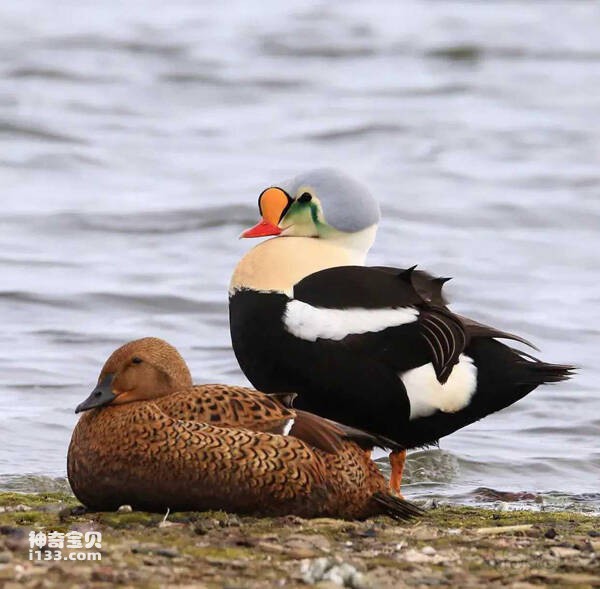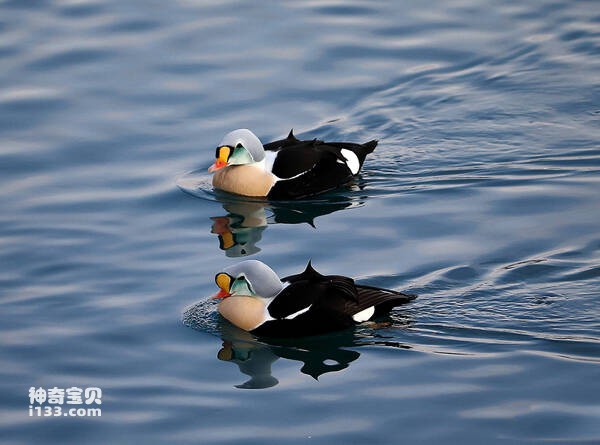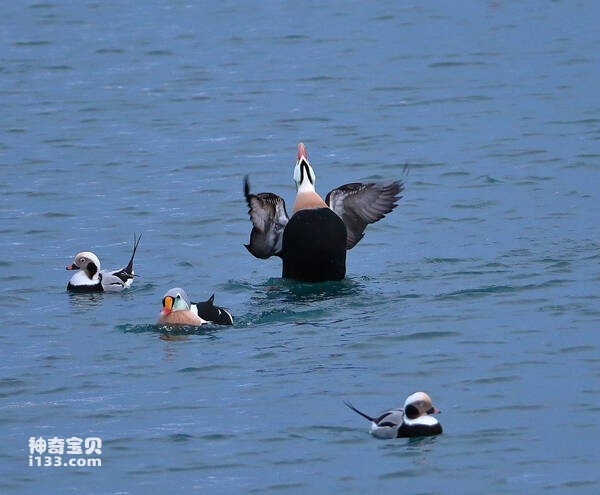King Eider
IUCN
LCBasic Information
Scientific classification
- name:King Eider
- Scientific Name:King Eider,Somateria spectabilis
- Outline:Waterfowl
- Family:
Vital signs
- length:53-60CM
- Weight:1.5-2.01kg
- lifetime:No textual research information is available
Feature
It's the largest sea duck
Distribution and Habitat
Country of origin: Canada, Denmark, Finland, Greenland, Iceland, Japan, Norway, Russian Federation, Saint Pierre and Miquelon, Svalbard and Jan Mayen, Sweden, United States.
Wandering: Belarus, Belgium, Czech Republic, France, Germany, Hungary, Ireland, Italy, Kazakhstan, Latvia, Lithuania, Netherlands, Poland, Portugal, Spain, United Kingdom.
It breeds in the Arctic tundra and spends the rest of its life in aquatic environments, but there are exceptions. In winter, it appears on the ice of bays and fjords.
Appearance
The king Eider is 53-60 cm long, has a wingspan of 94 cm, and weighs 1500-2010 g. The male duck has a large wedding hat that covers his face from the top of his head to the neck, a colorful mask and helmet made up of light gray, blue, green and red, and an orange-red mouth with a rectangular covering panel. The back two-thirds of the body is black, in stark contrast to the white of the back, throat, and chest. The feathers on his back are quite prominent. The female duck is uniformly tan with darker markings composed of brown, and the underbody plumage is a mixture of brown and white.
Details
King Eider (Somateria spectabilis), no subspecies.

King Eider ducks are the largest sea ducks, and some have migratory behavior. Like other eider ducks, this species is native to the far North. Breeds on icy coasts as far south as Holland and St. Lawrence Bay; Wintering as far south as France, New England, and the Aleutian Islands.

King eider ducks get most of their food from the sea floor, so they like to swim in the shallow waters of the continental margins. It consumes large quantities of mussels and other shellfish, small fish, crustaceans, squid and sea urchins. To catch their prey, Eider ducks are excellent divers, diving to depths of up to tens of meters. Because it is mainly a terrestrial ecological model, its eating habits vary greatly, so the diet of insects is also an important part of the king Eider duck. During the winter they are not entirely carnivorous and usually eat algae and Marine plants as well.

In the late summer of each year, when the Arctic islands are surrounded by water, the king Eider ducks begin to nest and breed on the islands, usually under driftwood or clumps of seaweed, to shelter them from the wind. The female duck uses a large number of branches, leaves, grass, seaweed and other nesting bottom, and arranges the fluff in the nest for lining. The nest should be in a sheltered area of rock or vegetation. Foraging under the tide during the day, diving 10-18m depth, using wings to paddle underwater, and flying straight out of the water with wings. A hard shell and its gizzard capable of crushing shells. Female eider ducks lay 3 to 6 eggs per clutch, the color of the eggshells are light olive oil, brown olive oil and gray olive oil, and the eggs are 7.6 cm long. What is surprising is that the nesting area of the king Eider duck is very close to the nest of a kind of seagull, and this kind of seagull is not easy to get along with, is the hunter of the eggs and chicks of the eider duck, the king Eider duck like to do with this seagull is precisely the power of this seagull, to drive away its more powerful enemies such as skuas, Arctic foxes, etc., so that the seagull protects its own nesting area, but also to protect the king eider duck from harm.
King Eider ducks are monogamous, incubated by the female for 21 to 24 days. During this period, female eider ducks rarely leave their nest area and concentrate on breeding. After hatching, the young are led by the female duck and come to the sea together, playing while constantly diving into the water to get food. Under normal circumstances, several families of eider ducks will join together and live a collective life, like a kindergarten. Flying began after 56 days, and by September, they were able to spread their wings and head west to winter in the Bering Sea and the Gulf of Alaska.
Listed on the International Union for Conservation of Nature (IUCN) 2013 Red List of Threatened Species ver 3.1 - Low Risk (LC).
Protect wild animals and eliminate wild meat.
Maintaining ecological balance is everyone's responsibility!








